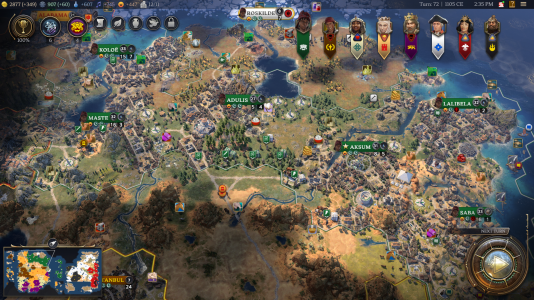The town/city relationship and the proper ratio of the two settlement types is one of the most interesting new features of the Civ VII economy. The most popular informed take I’ve seen is something like “more towns than cities in Antiquity, scaling to around three towns per city later in the game”. This is also how I played my first few games, but I’ve grown interested in exploring city-heavy strategies, trying to see just how much value can be extracted from the economic golden ages.
After a handful of test runs, I’ve landed on the “six-city zero-town Antiquity” strategy as an interesting approach. Why six cities? Couple reasons:
We enter Exploration era with three priorities:
I think people are severely underrating spreading religion because it’s temporary. But the short-term value is immense – let’s say you get the “four science per foreign settlement” belief. Your Missionaries will give you unbeatable science ROI for as long as you can count on converting a full city per charge. Will the AI Missionary spam that kicks in mid-era prevent you from keeping these cities converted? Yeah, it will. But see the list of priorities above – if the yields from religion help fuel the race to Shipbuilding, that’s worth it, and it’s ok that you won’t get to keep everything all era long.
Attached are a couple screenshots from a successful example game – Amina leading Aksum into Chola on Deity/Standard/Standard. Key benchmarks: Sixth distant lands settlement founded on turn 18. Shipbuilding researched on turn 31. Final legacy path (Economic) cleared on turn 72, ending the age.
Is this the best way to play? Probably not. Is this a good way to play? Yeah, I think so, especially if your goals are something like “complete the full Exploration legacy grand slam in the short time you have available at high difficulty”.
After a handful of test runs, I’ve landed on the “six-city zero-town Antiquity” strategy as an interesting approach. Why six cities? Couple reasons:
- Attainability. Converting towns to cities costs a lot of gold past the first couple, and every town you convert to a city further sacrifices gold income. I’ve found that there’s usually just enough time to create six cities and sufficiently develop the last couple to justify the cost of converting them. Setting up 7+ developed cities is possible, but it may not be easy at high difficulty.
- Exploration era settlement cap. I think that it’s ultra important to spam out as much rapid expansion as you can afford early in the Exploration era. This means pushing well over the cap for a while. More settlements in Antiquity = more happiness penalties and more time over the cap in Exploration. That can be mitigated, but I’m trying to be attentive to the issue and build in a way to maximize my per-settlement yield coming out of Antiquity.
We enter Exploration era with three priorities:
- Have enough gold and hammers to buy a second Cog on turn 1 and ready six Settlers to start crossing the ocean the instant Cartography unlocks.
- Carry over enough science from Antiquity to research Cartography relatively quickly. There are diminishing returns to this, since we also need time to get our Settlers out. Ideally Cartography takes no more than eight turns to unlock.
- Scale enough early-Exploration science to get to Shipbuilding ASAP.
I think people are severely underrating spreading religion because it’s temporary. But the short-term value is immense – let’s say you get the “four science per foreign settlement” belief. Your Missionaries will give you unbeatable science ROI for as long as you can count on converting a full city per charge. Will the AI Missionary spam that kicks in mid-era prevent you from keeping these cities converted? Yeah, it will. But see the list of priorities above – if the yields from religion help fuel the race to Shipbuilding, that’s worth it, and it’s ok that you won’t get to keep everything all era long.
Attached are a couple screenshots from a successful example game – Amina leading Aksum into Chola on Deity/Standard/Standard. Key benchmarks: Sixth distant lands settlement founded on turn 18. Shipbuilding researched on turn 31. Final legacy path (Economic) cleared on turn 72, ending the age.
Is this the best way to play? Probably not. Is this a good way to play? Yeah, I think so, especially if your goals are something like “complete the full Exploration legacy grand slam in the short time you have available at high difficulty”.



